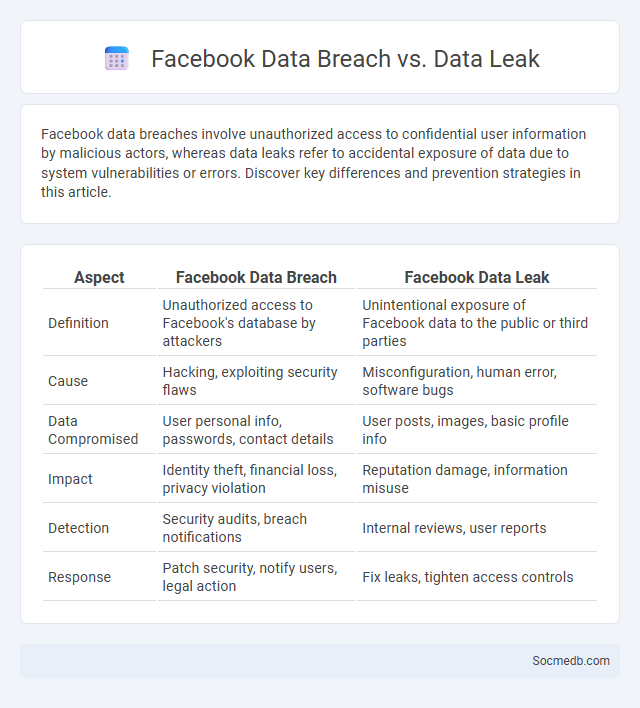
Photo illustration: Facebook Data Breach vs Data Leak
Facebook data breaches involve unauthorized access to confidential user information by malicious actors, whereas data leaks refer to accidental exposure of data due to system vulnerabilities or errors. Discover key differences and prevention strategies in this article.
Table of Comparison
| Aspect | Facebook Data Breach | Facebook Data Leak |
|---|---|---|
| Definition | Unauthorized access to Facebook's database by attackers | Unintentional exposure of Facebook data to the public or third parties |
| Cause | Hacking, exploiting security flaws | Misconfiguration, human error, software bugs |
| Data Compromised | User personal info, passwords, contact details | User posts, images, basic profile info |
| Impact | Identity theft, financial loss, privacy violation | Reputation damage, information misuse |
| Detection | Security audits, breach notifications | Internal reviews, user reports |
| Response | Patch security, notify users, legal action | Fix leaks, tighten access controls |
Understanding Facebook Data Breach: Definition and Implications
A Facebook data breach occurs when unauthorized parties access users' personal information, compromising privacy and security. This incident exposes sensitive data such as names, email addresses, phone numbers, and sometimes financial details, increasing the risk of identity theft and fraud. Understanding the implications helps you implement stronger security measures to protect your online presence and personal information.
What is a Data Leak? Key Differences from Data Breach
A data leak occurs when sensitive information is unintentionally exposed or accessed without authorization, often due to misconfigurations or human error, affecting platforms like social media where user data is abundant. Unlike a data breach, which involves a deliberate cyberattack or hacking incident to steal or compromise data, a data leak typically results from vulnerabilities or oversight rather than malicious intent. Understanding these distinctions is crucial for social media companies to implement effective security measures and protect user privacy.
The Anatomy of a Facebook Data Breach Incident
The anatomy of a Facebook data breach incident involves unauthorized access to user information through vulnerabilities exploited by hackers, often targeting application programming interfaces (APIs) and third-party apps integrating with Facebook's platform. Attackers extract data such as user profiles, friend lists, contact information, and sometimes private messages, compromising millions of users' privacy and security. Facebook's breach response typically includes patching security gaps, notifying affected users, and cooperating with regulatory authorities to mitigate the impact and enhance future protections.
Common Causes of Facebook Data Leaks
Facebook data leaks commonly result from user misconfigurations, such as weak privacy settings that expose personal information to the public. Third-party app integrations with insufficient security measures often create vulnerabilities for unauthorized data access. Ensuring your account uses strong passwords and limiting app permissions can significantly reduce the risk of data breaches.
Comparing Data Breach and Data Leak: Terminology Explained
A data breach occurs when unauthorized individuals gain access to sensitive information, often through hacking or cyberattacks, whereas a data leak involves accidental exposure of data without malicious intent. Understanding the distinction is crucial for protecting Your personal information on social media platforms, as breaches typically signal a security failure, while leaks often result from misconfigurations or poor data handling. Both issues highlight the importance of robust privacy measures and immediate response strategies to safeguard Your online presence.
Real-World Examples: Facebook Data Breach vs Data Leak
The 2019 Facebook data breach exposed the personal information of over 530 million users, highlighting the risks of centralized data storage on social media platforms. In contrast, a data leak often involves unintentional exposure, such as the 2021 Twitter data leak where phone numbers and email addresses of 5.4 million users were accessible due to a vulnerability. Real-world events emphasize the critical need for robust cybersecurity measures and transparent incident response protocols within social media companies to protect user privacy.
Impact on Users: Data Breach vs Data Leak on Facebook
Facebook data breaches expose users' sensitive information through unauthorized access by hackers, leading to identity theft and financial loss. Data leaks, however, often result from unintentional exposure due to platform vulnerabilities or user errors, compromising privacy and user trust. Both incidents significantly impact user security, but data breaches typically involve more deliberate and harmful exploitation of personal data.
Preventing Data Breaches and Leaks on Social Media
Preventing data breaches and leaks on social media requires implementing strong privacy settings and regularly updating passwords to protect your accounts from unauthorized access. You should enable two-factor authentication and be cautious about sharing sensitive information or clicking on suspicious links. Monitoring account activity and educating yourself about phishing tactics further strengthens your defense against potential data compromises.
Legal Consequences of Facebook Data Breaches and Leaks
Facebook data breaches expose your personal information to identity theft, financial fraud, and unauthorized access, leading to significant legal consequences for both the company and affected users. Organizations face hefty fines, regulatory investigations, and lawsuits under data protection laws like GDPR and CCPA, emphasizing the critical importance of robust cybersecurity measures. Users may pursue legal action for damages resulting from compromised sensitive information, highlighting the need for vigilance in safeguarding your online privacy.
Best Practices for Protecting Personal Data on Facebook
Ensure your Facebook privacy settings are configured to limit data visibility to trusted friends and avoid sharing sensitive information publicly. Regularly review app permissions and remove third-party apps that access your personal data without necessity. You can enhance your account security by enabling two-factor authentication and monitoring login activity for unauthorized access.
 socmedb.com
socmedb.com